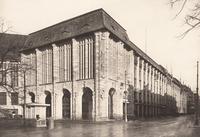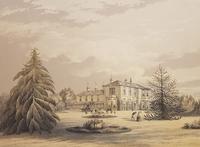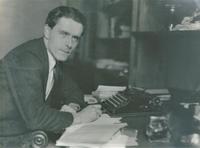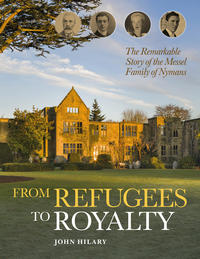Writing the Messel family history: a labour of love
Any act of writing is bound to be a voyage of discovery. Yet the twelve years I spent researching From Refugees to Royalty: The Remarkable Story of the Messel Family of Nymans opened up whole new dimensions of learning to me that I had never explored before. Knowing that family history is of interest only when it becomes social history, I immersed myself in reading about the times and tribulations through which the Messels lived. That reading taught me about the history of the Jewish communities in Germany and Britain, but it also enabled me to explore deeper questions of identity, culture and belonging. And it turned the writing of the book into a genuine labour of love.
To begin with, tracing the Messel family roots has given me a new appreciation of the socio-cultural development of German Jewry from the eighteenth century onwards. There can be few fields of scholarship as rich as the study of the German-Jewish experience down the ages, with its impassioned debate over whether there was ever any real dialogue between the dominant German and minority Jewish cultures. The rise of the Messel family shows how successfully ‘privileged Jews’ integrated into German society. Yet the leading role that my ancestors Aron and Simon Messel played in the Jewish community of Darmstadt proves that even the most acculturated Jews could retain their ancestral faith.

The Wertheim department store, Berlin (photo TU, Berlin)
Alongside this context, it has been fascinating to learn more about the most famous member of the family to have remained in Germany, the architect Alfred Messel. I had already visited his surviving buildings in Berlin and Darmstadt, but it was reading the academic literature on his work that revealed the full extent of his influence on leading modernist architects such as Erich Mendelsohn and Ludwig Mies van der Rohe. Alfred’s pioneering designs for the Wertheim department store in Berlin carried a resonance far beyond architecture alone, as they challenged the antisemitic conservatism of the Wilhelmine era through a more inclusive idiom still rooted in German culture. I was equally excited to learn of his contribution to the urban reform movement that provided social housing for Berlin’s growing working-class population, a movement that was spearheaded by German Jews.
All four of Alfred Messel’s siblings emigrated to England, which in turn raises the question of why so many Jews from prosperous backgrounds chose to leave Germany in the nineteenth century and build new lives abroad. There were clearly both push and pull factors involved, and personal memoirs from other German-Jewish contemporaries help to explain the reasoning behind the decision. While Britain was not always a welcoming environment to foreigners, it clearly offered greater freedom and opportunity to German-Jewish migrants than the restricted society they left behind. For those like the Messels with a family background in banking, London held a particular attraction as the undisputed finance capital of the world.

The original Regency house at Nymans
Once they arrived in England, the Messels set about putting down roots and integrating into their new home environment. Nothing exemplifies this better than their decision to purchase the country estate of Nymans in West Sussex, today one of the National Trust’s most popular properties. My great-great-grandfather Ludwig Messel, who bought Nymans in 1890, wanted a rural retreat where he could enjoy family life away from the cares of the City and where he could indulge his new-found passion for gardening. It has been instructive to compare this private motivation with the grander ‘power houses’ bought or built by other Jewish families during the nineteenth century, most notably the Rothschilds in the Vale of Aylesbury.
The Messel family successfully established itself in their new environment, with Ludwig’s elder son Leonard rising to become High Sheriff of Sussex in 1936. Leonard’s younger two children Anne and Oliver Messel were celebrated figures in London society during the interwar years, and Oliver found lasting fame as the leading British stage designer of the mid-twentieth century. Yet it was Anne’s son Tony Armstrong-Jones, later Lord Snowdon, who would become the most famous member of the Messel family when he married Princess Margaret in 1960. A new generation has recently witnessed this stormy episode of royal history through the Netflix drama series The Crown, even if few will have been aware of Tony’s family past.

Rudolph Messel at his typewriter (Private Collection)
One of the most satisfying aspects of writing the book was to bring my mother’s Uncle Rudolph into the public eye. Oxford-educated and intellectual, Rudolph forged a very different career path from his high-society relatives, becoming a committed socialist and pacifist during the interwar years. Having stood for parliament (unsuccessfully) as a Labour MP, Rudolph used his Messel wealth to fund a range of socialist education initiatives in the 1930s and then to help Jewish and other refugees escape Nazi Germany, including the remaining Messel cousins who still lived in Berlin. His life has been overshadowed by the glamour of his more famous relatives, and I was pleased to redress the balance somewhat by telling his story alongside theirs.
One further objective of the book was to draw out the life stories of the Messel women, whose contribution was at least as important as the men’s. Ludwig Messel’s youngest daughter Muriel was an independent Edwardian woman with a deep knowledge and love of plants, as demonstrated in her marvellous compendium A Garden Flora, published just after her untimely death in 1918. Maud Messel was the driving force behind the 1920s redesign of Nymans, when the extended Regency villa was replaced with a faux medieval manor house in the Old English tradition. Her equally strong-willed daughter Anne, Countess of Rosse founded the Victorian Society, curated the Messel collections of fans and dresses, and established Linley Sambourne House in Kensington as the unique museum it remains today. It is not always easy to restore the female side of a family history when so much documentary evidence is skewed towards the male, but I hope that the book has gone some way towards making these and other Messel women visible once more.
John Hilary, October 2021

From Refugees to Royalty: The Remarkable Story of the Messel Family of Nymans is available to order from all usual book retailers, or from the website: fromrefugeestoroyalty.com.



